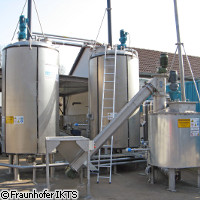Turning corn stalks into electricity
Scientists from the Fraunhofer Institute for Ceramic Technologies and Systems (IKTS) in Germany have succeeded in developing the first-ever pilot biogas plant which strictly uses organic waste instead of edible raw materials. Another highlight of their work is a fuel cell capable of converting the gas into electricity. A major boon for Europeans, the facility has 30% more generation capacity over its predecessors. The IKTS team said support for putting an end to the use of edible raw materials, like corn, is growing. More specifically, people are protesting against the fermentation of foodstuffs in biogas plants that produce electricity and heat. According to them, electricity produced in this manner could trigger a rise in food prices. The IKTS scientists worked together with a number of small and medium-sized enterprises (SMEs) to develop the state-of-the-art biogas plant. 'In our pilot plant, we exclusively use agricultural waste such as corn stalks - that is, the corn plants without the cobs,' explained Dr Michael Stelter, head of the IKTS Department. Before this groundbreaking development, biogas plants were only able to process a specific proportion of waste material. So converting waste instead of pure cereal crops or corn into biogas was a tricky process. The upshot is that the scientists noted a 50% to 70% drop in the time needed to store the decomposing waste material with the use of this new and innovative plant. According to the team, biomass is typically stored in the 'fermenter' for a period of 80 days so that biogas can be developed. This latest pre-treatment reduces the waiting period to around 30 days. 'Corn stalks contain cellulose which cannot be directly fermented,' Dr Stelter said. 'But in our plant, the cellulose is broken down by enzymes before the silage ferments.' Through their research, the scientists were able to optimise the conversion of biogas into electrical power. They said the gas was diverted into a high-temperature fuel cell with 40% to 55% power efficiency, against the 38% efficiency achieved with a gas engine. The IKTS team explained that the fuel cell operates at 850 degrees Celsius, and the heat can be used directly for heating. The district heating network can also be supplied with the heat, they added. By combining electrical and thermal efficiency, we can get a fuel cell efficiency of up to 85%. The scientists said overall efficiency of the combustion engine averages some 38% because containing the heat is difficult to do. The pilot plant constructed by the scientists can generate 1.5 kilowatts of power, and this amount can cover the needs of one household, they explained. The team plans to present the concept of the biogas plant at the Hannover-Messe 2009, which will run from April 20 to 24. Hannover-Messe consists of 10 international flagship trade fairs covering a wide range of topics, including energy and power plant technology. The next phase of the project is to work on gradually increasing the generation capacity of the biogas plant to two megawatts.
Countries
Netherlands



